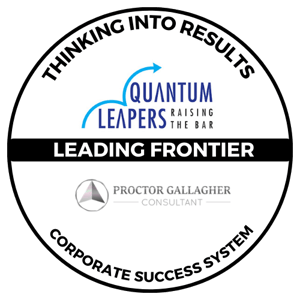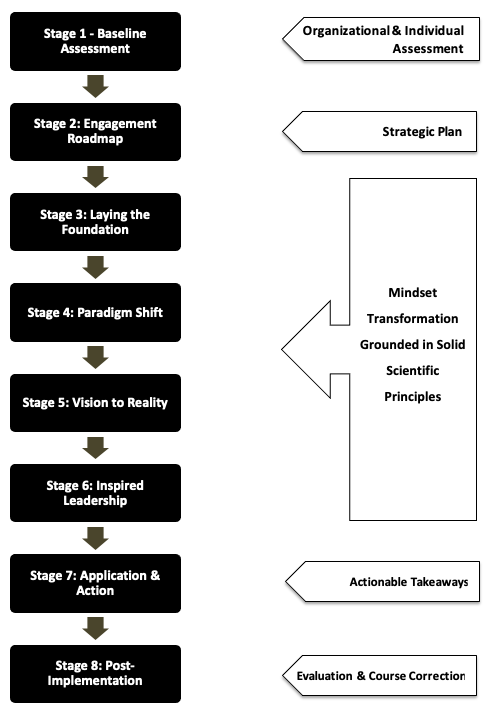Leading Frontier
Signature Blueprint Program Pioneered by
Proctor Gallagher Institute (PGI)

Corporate Success System
Scientifically Proven Mindset & Team Compound System
Pioneered by the World's #1 Expert on Human Potential
Description of Engagement
Empower teams to perform at their peak in months using a proven mindset and team compound system. This transformative 12-week journey focuses on harnessing the power of Thinking Into Results for exceptional results.
High-level Outcomes
1. Develop and implement a strategic plan for setting and attaining realistic goals.
2. Maximise the efficiency of resource allocation to enhance financial returns.
3. Implement innovative approaches to significantly boost workplace productivity.
4. Train teams to consistently operate at their maximum potential.
5. Foster a culture that encourages innovative thinking and proactive problem-solving.
6. Establish a strong and unified team identity aligned with organisational values.
7. Identify and effectively overcome key obstacles hindering team success.
8. Ensure all team activities are directly contributing to the company's overarching vision.
9. Cultivate a growth mindset focused on continuous improvement and high achievement.
10. Develop leadership skills that inspire and guide teams towards success.
11. Enhance customer service to drive profitability and long-term customer loyalty.
12. Strengthen the team's ability to collaboratively solve complex problems efficiently.
Target Audience
- > Achievers
- > Managers
- > Entrepreneurs
- > Mindset Seekers
- > Problem Solvers
- > Science Enthusiasts
- > Teams
Enrolment Prerequisite
Participants with corporate experience, preferably in executive or leadership positions.
.jpg?width=400&height=85&name=Logo_Proctor%20Gallagher%20Consultant%20(light%20background).jpg)
Delivered by Proctor Gallagher Institute (PGI) Certified Consultant

Staged High-Level 12 Weeks Engagement Roadmap
Engagement Outline
-
Benefits: Explains how to set and achieve goals that promote quantum leaps. Teaches the process of setting and achieving team goals.
-
Outcome: Employees set goals that inspire them, which helps to move them forward. Employees are motivated and see themselves as a part of something bigger
-
Benefits: Most training gives employees information on how to do their job, but it seldom results in better results because their paradigm keeps them from acting on what they know.
-
Outcome: Helps employees implement what they already know. Changes their behaviour to close the gap between what they know and what they actually do.
-
Benefits: Employees will turn their non-productive habits into productive habits and become more efficient and productive in their job.
-
Outcome: Leads to an increase in the bottom line for the company. Leads to a reduction in turnover. Leads to an increase in retention and performance.
-
Benefits: Teaches how the mind works. Employees take a close look at their daily habitual action to see where they can become more productive.
-
Outcome: Team performance is improved through increased productivity of each individual. Employees and teams can break from past results and habitual behaviors. Productivity and efficiency increase as employees and teams work better together.
-
Benefits: Teaches people how to think and how to analyse their thinking, helps them realise past results are a reaction of past thinking and to change what they are getting they have to change their thinking.
-
Outcome: Helps teams to develop creative, innovative solutions to problems. Employees see problems as opportunities to strengthen the team, which can be measured in the increase in success.
-
Benefits: Employees will understand that to be more productive they have to change their image of themselves.
-
Outcome: Teams become more productive as they improve their team image. Teams focus less on what the competition is doing and more on what they are capable of achieving as a team.
-
Benefits: Creates an open environment for people to talk about fears so they can replace them with positive thoughts and get support from other team members.
-
Outcome: They can create effective teams. They can help other members overcome their fears. They are better able to think of creative solutions to problems.
-
Benefits: Employees can see the connection between their beliefs and behaviour.
-
Outcome: Their results can then match the company mission and goals. Employees help create a vision of a perfectly functioning team that is reaching its potential. They create the results they are capable of creating together.
-
Benefits: Gives a complete definition of attitude. This lesson explains what it is and how to change it.
-
Outcome: Focused teams that have their thoughts, beliefs, and actions aligned so that they are more productive and efficient. They learn the way to create a positive attitude regardless of the situation
-
Benefits: Helps employees develop qualities of leadership in addition to being able also to be good followers. Emphasises the creation of a positive environment where employees are appreciated for the work they do.
-
Outcome: Creates cooperation among team members and a positive work environment. Allows team members to emerge in leadership roles, which strengthens the team overall.
-
Benefits: Emphasises giving with no expectation of return or service to others.
-
Outcome: Promotes a high-performance standard for all levels in the company—leaders and employees are encouraged to do more and give more than expected. Teams will look for ways to make customers and other team members feel valued and appreciated.
-
Benefits: This program lays out the steps for a quantum leap, leading to dramatic results in performance.
-
Outcome: Employees are shown ways to sustain success to keep improving and improving at their work. Magnifying the Mind results in employees and teams that are focused and empowered with unprecedented increases in performance; you will be able to measure
Course Includes:
- Duration: 12 Weeks
- Minimum Contact Hours: 24 Hours
- Minimum Non-Contact Guided Hours: 72 Hours
- Mode of Delivery: Online /Onsite
- Pre-Training Engagement: YES
- Post-Training Engagement: YES
- Certificate: YES
- Trainer: PGI Certified Consultant
-
Capacity:
2 pax (min) to 10 pax (max) [for maximum value & engagement]
INDUSTRIES WE'VE IMPACTED
- Product Development
- Manufacturing
- Financial Services
- Healthcare
- Consulting
- Retail
- Government
- Non-Profit Organisations
- Marketing, Sales and Advertising
- Education
- Telecommunications
- Construction
- Software Development
- Information Technology
-
IMMERSIVE LEARNING PATHWAYS
-
Leading Self
Leading Others
> Winning Persona: Personal Branding Boost Program
> Empowering Confidence, Communication & Pressure Management
Customised Programs > Mastering Change in a VUCA Environment
> Value Uplift: Elevating Subsidiaries And Energising Boards
-
-
-3.png?width=175&height=88&name=Logo_Quantum%20Leapers%20(light%20background)-3.png)
.png?width=1689&height=848&name=Logo_Quantum%20Leapers%20(dark%20background).png)